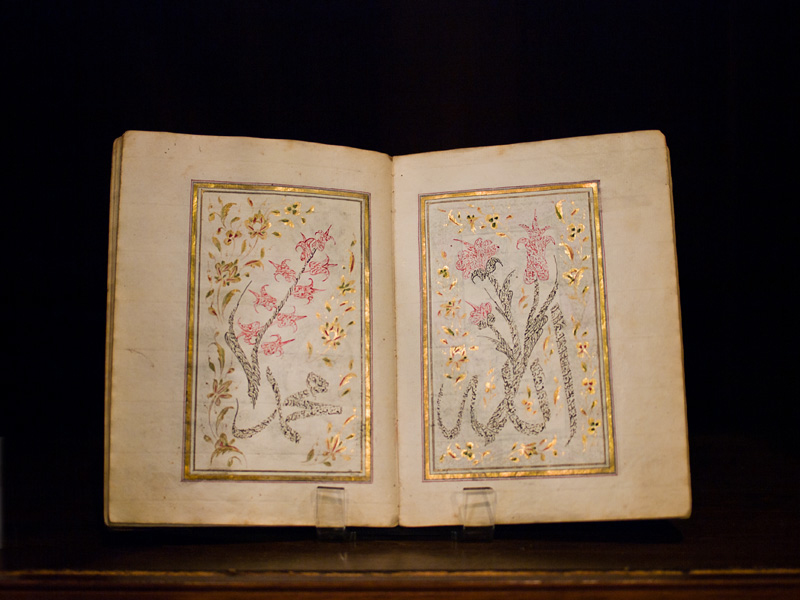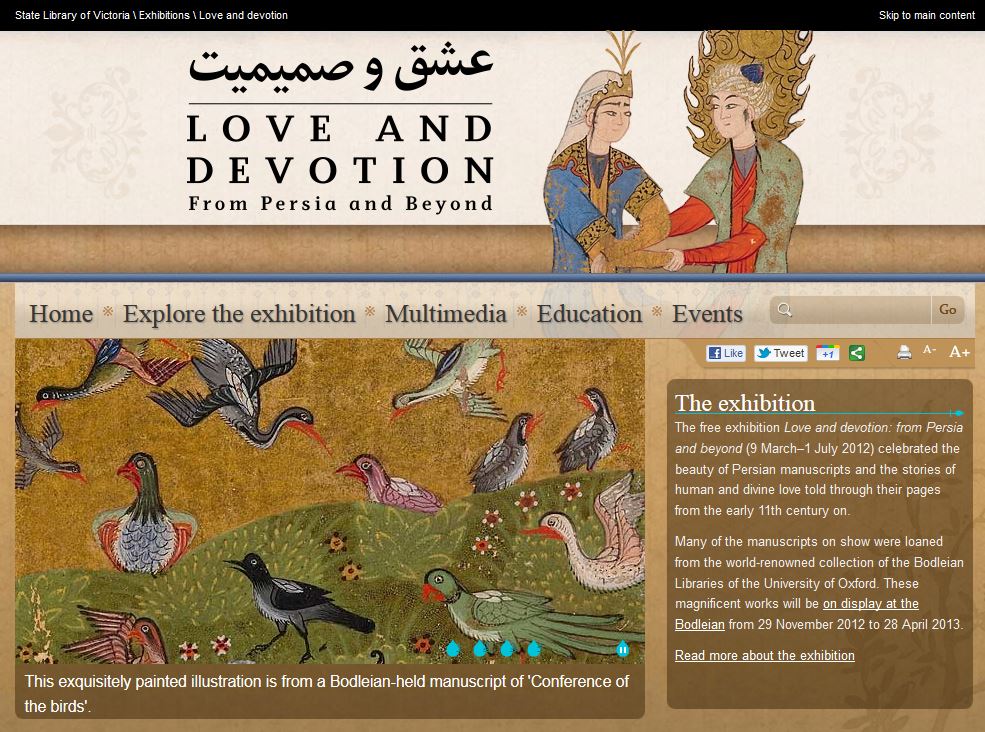Ten years ago, the first items from the Islamic Studies Library (ISL) collection located in Rare Books and Special Collections (RBSC) were digitized. Over the years, the Islamic Studies Library and Digital Initiatives (DI) have developed a strong link, and the history of this decade-long collaboration is worth sharing with our community. This continuous teamwork resulted in launching multiple digital exhibitions, an Internet Archive ISL Collection and various research projects.
Digital Exhibitions and Collections
The first collaboration, Beautiful calligraphy ensures entrance to Paradise, started with a physical display in the Islamic Studies Library from November 1st, 2010 to March 31st 2011. The Calligraphy panels came from McGill University’s Rare Books and Special Collections and the Islamic Studies Library holdings located in RBSC. The physical exhibition included sixteen items representing various styles of Arabic calligraphy: from dry black and white calligraphy of the 10th century to colorful illuminated pieces of the 19th century, all of which recounted a brief history of Arabic/Islamic calligraphy. The Digital Exhibit: http://digital.library.mcgill.ca/islamic_calligraphy/index.php.
The second collaboration, The Shahnameh by Ferdowsi, also started as a physical display in the Islamic Studies Library, from April 1st to October 31st, 2011. Here again, the physical exhibition included sixteen Shahnameh folios coming from McGill University’s Rare Books and Special Collections and the Islamic Studies Library holdings located in RBSC. Shahnameh by Ferdowsi offered the visitor an opportunity to experience some of the heroes and villains of this remarkable epic poem and to gather a diverse overview of this celebrated text as well as the magnificence of Persian painting. The Digital Exhibit: http://digital.library.mcgill.ca/shahnameh/index.php.
The third collaboration, Arabic Lithographed Books, drew upon selections from Arabic lithographed books. The collection was on display in the Islamic Studies Library between February 1st and September 30th 2014, and later formed the basis for the Islamic Lithographs digital collection. Since then, the digitization of Islamic lithographs at McGill has become a work in progress, and the resulting digital collection a continually updated resource. This Collection includes many examples of lithographed books in Arabic, Persian, Ottoman Turkish, and Urdu, dated from the eighteenth century until the mid-twentieth century showcasing different calligraphic styles, graphic designs, and publishing houses from the Muslim world and Europe. Items from the Islamic Lithographs digital collection were the first to be uploaded to the Islamic Studies Library Internet Archives collection. The Digital Exhibit: http://digital.library.mcgill.ca/islamic_lithographs/.
Exhibits photo credit: Klaus Fiedler
INTERNET ARCHIVE
Since 2014, an increasing number of digitized materials from the ISL’s various collections have become accessible on Internet Archive, a non-profit library of millions of free books, movies, software, music, and more. Digital Initiatives uploads digitized materials twice a year. This unique collaboration began with 395 items and today includes digital copies of well over 1279 Arabic, Persian, Ottoman Turkish and Urdu manuscripts, lithographs and rare books from the ISL collection. The materials can be viewed and browsed using the Internet Archive book reader, or downloaded in PDF format. The RSS feed feature of the Internet Archive website offers the opportunity to stay informed of new additions to our collection. Internet Archives Islamic Studies Collection : https://archive.org/details/mcgilluniversityislamicstudies

On demand digitization
Among the first to use this service were two faculty members from the Institute of Islamic studies; Professors F. Jamil Ragep and Robert Wisnovsky selected around 30 manuscripts from the ISL collection and the Osler Library of the History of Medicine collection to be digitized for a joint research project. (Rational Science in Islamic (RASI) project: https://islamsci.mcgill.ca/RASI/). In general, items for personal or scholarly use can be submitted for approval to be digitized by consulting McGill University’s on demand digitization service. Digitized items become available online in full in accordance with Canadian Copyright Law.
Behind the scenes: Digitization at the Library (Video)
A short video created in December 2019 highlights the meticulous work that takes place at Digitization and Digital Initiatives. The Library’s digitization service captures and provides access to millions of pages and objects from the vast and varied collections of McGill Libraries. This service is now even more important and essential during this unprecedented period of remote instruction and library online services.
Special Thanks
Blog post editors: Anaïs Salamon, Head Librarian, Dr. Charles Fletcher, Head Library Clerk, and Greg Houston, Digital Initiatives































 Multimedia section includes audio recordings of Persian poetry readings and video recordings of past conferences that address the theme of Love and devotion.
Multimedia section includes audio recordings of Persian poetry readings and video recordings of past conferences that address the theme of Love and devotion.












